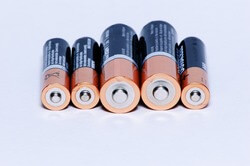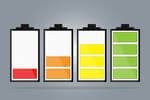News Release from windfair.net
Wind Industry Profile of
Bringing Together Nature's Elements: Scientists Develop Water-Based Battery for Storing Wind and Solar Energy
The prototype of a manganese-hydrogen battery, which was presented in the Nature Energy magazine at the end of April, is just under 7 centimetres in size and generates only 20 milliwatt hours of electricity corresponding to the energy level of LED flashlights hanging on a key ring. Despite the low performance of the prototype, researchers are confident that it will be possible to scale the battary to an industrial-grade system that can be recharged up to 10,000 times. This would give the battery a service life of well over ten years.
This may be the missing piece in the puzzle to decisively advance energy transition, as manganese-hydrogen battery technology are able to store wind and solar energy for times when renewable sources momentarily cannot supply electricity.
“What we’ve done is thrown a special salt into water, dropped in an electrode, and created a reversible chemical reaction that stores electrons in the form of hydrogen gas,” says Yi Cui, Professor of Materials Science at Stanford University, explaining the chemical process. Essentially, the researchers have stimulated a reversible electron exchange between water and manganese sulphate, a cheap and abundant salt for the production of dry batteries, fertilizers, paper and other products.
 Cui estimates that, given the expected life of the water-based battery, it would cost a penny to store enough power to keep a 100-watt light bulb on for twelve hours. He is convinced that the technology will one day be able to store energy on an industrial scale. But we are not there yet. The prototype (Image to the right: Jinwei Xu/Stanford University) looks promising, but it will be a while before the battery can really be built on a large scale.
Cui estimates that, given the expected life of the water-based battery, it would cost a penny to store enough power to keep a 100-watt light bulb on for twelve hours. He is convinced that the technology will one day be able to store energy on an industrial scale. But we are not there yet. The prototype (Image to the right: Jinwei Xu/Stanford University) looks promising, but it will be a while before the battery can really be built on a large scale.
According to estimates by the Department of Energy, about 70 percent of the electricity in the US is still generated by coal or natural gas plants, which account for 40 percent of the country's carbon dioxide emissions. Though the switch to wind and solar energy offers the possibility of reducing these emissions, it also poses the challenge of being able to react variably to the volatile natural resources. The grid must also be able to react to fluctuating demand and have appropriate reserve capacities available. Batteries offer a way to do this on a large scale.
The new battery technology offers the advantage of far lower costs compared to other batteries. Rechargeable lithium-ion batteries used in mobile phones and laptops e.g., are too expensive for larger scales as they are based on expensive rare earths. That would drive the costs of storing electricity for an entire city to an immense level. The manganese-hydrogen process seems to be a highly promising alternative.
- Author:
- Windfair Staff
- Email:
- press@windfair.net
- Keywords:
- storage, battery, Standford University, research, report, wind, solar, manganese-hydrogen

























